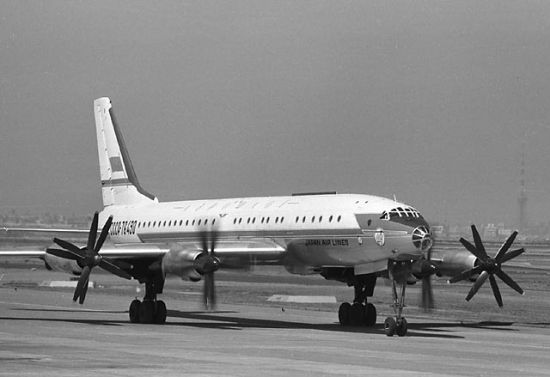Number of Aircraft Propeller Blades
Why do different aircraft have different numbers of propeller blades on their engines?
- question from name withheld
Aircraft powered by piston or turboprop engines often feature different numbers of
propeller blades, ranging from two or three on many light general aviation aircraft to four or more on large
bombers or transport planes. The maximum number of blades ever used on a propeller is probably eight. The reason
propeller design varies so is most often related to the power produced by the engine in question--more powerful
engines require more propeller blades.

Tupolev Tu-114 with some of the most powerful turporop engines ever built
Why is it that a more powerful engine would need more propeller blades? To understand this problem, it is
important to understand that a propeller must be tailored to the specific needs of an engine. The job of the
propeller is to "absorb" the power produced by the engine and transmit that power to the air flow passing through
the propeller disk. Thus, energy is added to the air to speed it up and generate a thrust force on the propeller
blades. If the propeller and engine are not properly matched depending on the power of the engine, both become
inefficient and performance suffers.
As engine power increases, the aircraft designer has a limited number of options to design a propeller capable
of efficiently absorbing that greater power:
- Increase the blade angle (or the pitch) of the propeller blades. In so doing, the
angle of attack of the blades increases allowing the
blades to impart greater energy to the air flow.
- Increase the diameter of the propeller disk, i.e. make the blades longer. The blades will
therefore transfer more energy by affecting a larger volume of air.
- Increase the revolutions per minute of the propeller. The same amount of energy is transferred
to the air but in a shorter time.
- Increase the camber (or curvature) of the blade airfoil. A propeller blade is composed of
airfoil shapes just like a wing is. Increasing the camber of a propeller blade creates a greater
thrust force just like increasing the camber of a wing creates a greater lift force.
- Increase the chord (or width) of the propeller blades.
- Increase the number of blades.
Unfortunately, many of these options create more problems than they solve and are generally impractical for a
variety of reasons.
- Blade angle: The pitch of the blade is set by the angle that optimizes the aerodynamic
efficiency of the blade. If this angle is changed, one kind of efficiency is lost in order to gain
another. This tradeoff makes changing the blade angle a very unattractive alternative.
- Blade length: While increasing tip speed is a significant issue (see the next point), size
constraints are usually the biggest problem with this option. As the propeller size increases, the
landing gear must become longer to avoid scraping the blade tips on the runway. This change has a
domino effect on a number of other structural and weight issues.
- Revolutions per minute: For the same propeller diameter, the blade tips travel faster and
faster as the rotational speed increases. Eventually, the blade tips become supersonic where shock
waves form, drag increases substantially, and efficiency plummets.
- Airfoil camber: The blade airfoils are chosen for optimum aerodynamic efficiency. By changing
sections, one kind of efficiency is again sacrificed for another. Increasing camber may also
result in blade structural problems.
We are now left with the final two options, increasing the blade chord or the number of blades. Both have the
effect of increasing the solidity of the propeller disk. Solidity simply refers to the area of the
propeller disk occupied by solid componenets (the blades) versus that area open to the air flow. As solidity
increases, a propeller can transfer more power to the air.
While increasing the blade chord is the easier option, it is less efficient because the aspect ratio of the blades
is decreased resulting in some loss of aerodynamic efficiency. Thus, increasing the number of blades is the most
attractive approach. As the power of engines increased over the years, aircraft designers adopted increasingly
more propeller blades. Once they ran out of room on the propeller hub, designers adopted twin contra-rotating
propellers on the same engine. Two good examples are the Tu-95 bomber
and Tu-114 airliner. These Russian aircraft were equipped with the
most powerful turboprop engines ever built, and both designs feature a total of eight propeller blades per engine.
- answer by Jeff Scott, 12 August 2001
Read More Articles:




